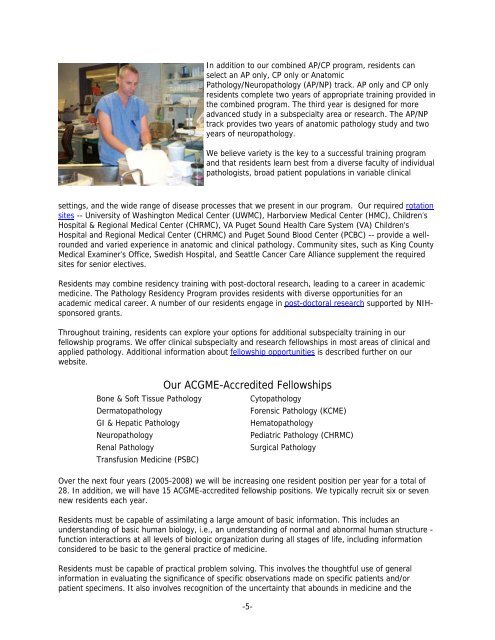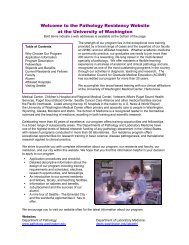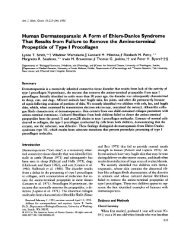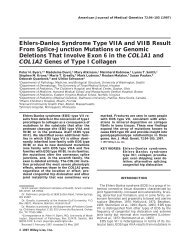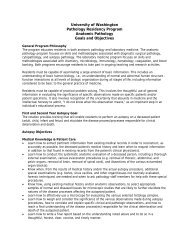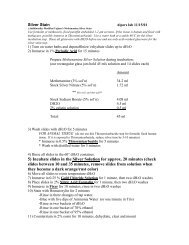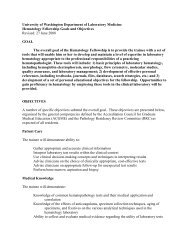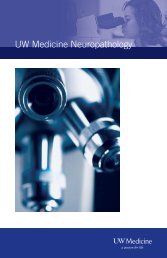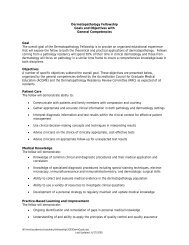Pathology Residency Program - Pathology - University of Washington
Pathology Residency Program - Pathology - University of Washington
Pathology Residency Program - Pathology - University of Washington
You also want an ePaper? Increase the reach of your titles
YUMPU automatically turns print PDFs into web optimized ePapers that Google loves.
In addition to our combined AP/CP program, residents can<br />
select an AP only, CP only or Anatomic<br />
<strong>Pathology</strong>/Neuropathology (AP/NP) track. AP only and CP only<br />
residents complete two years <strong>of</strong> appropriate training provided in<br />
the combined program. The third year is designed for more<br />
advanced study in a subspecialty area or research. The AP/NP<br />
track provides two years <strong>of</strong> anatomic pathology study and two<br />
years <strong>of</strong> neuropathology.<br />
We believe variety is the key to a successful training program<br />
and that residents learn best from a diverse faculty <strong>of</strong> individual<br />
pathologists, broad patient populations in variable clinical<br />
settings, and the wide range <strong>of</strong> disease processes that we present in our program. Our required rotation<br />
sites -- <strong>University</strong> <strong>of</strong> <strong>Washington</strong> Medical Center (UWMC), Harborview Medical Center (HMC), Children’s<br />
Hospital & Regional Medical Center (CHRMC), VA Puget Sound Health Care System (VA) Children's<br />
Hospital and Regional Medical Center (CHRMC) and Puget Sound Blood Center (PCBC) -- provide a wellrounded<br />
and varied experience in anatomic and clinical pathology. Community sites, such as King County<br />
Medical Examiner’s Office, Swedish Hospital, and Seattle Cancer Care Alliance supplement the required<br />
sites for senior electives.<br />
Residents may combine residency training with post-doctoral research, leading to a career in academic<br />
medicine. The <strong>Pathology</strong> <strong>Residency</strong> <strong>Program</strong> provides residents with diverse opportunities for an<br />
academic medical career. A number <strong>of</strong> our residents engage in post-doctoral research supported by NIHsponsored<br />
grants.<br />
Throughout training, residents can explore your options for additional subspecialty training in our<br />
fellowship programs. We <strong>of</strong>fer clinical subspecialty and research fellowships in most areas <strong>of</strong> clinical and<br />
applied pathology. Additional information about fellowship opportunities is described further on our<br />
website.<br />
Bone & S<strong>of</strong>t Tissue <strong>Pathology</strong><br />
Dermatopathology<br />
GI & Hepatic <strong>Pathology</strong><br />
Neuropathology<br />
Renal <strong>Pathology</strong><br />
Transfusion Medicine (PSBC)<br />
Our ACGME-Accredited Fellowships<br />
Cytopathology<br />
Forensic <strong>Pathology</strong> (KCME)<br />
Hematopathology<br />
Pediatric <strong>Pathology</strong> (CHRMC)<br />
Surgical <strong>Pathology</strong><br />
Over the next four years (2005-2008) we will be increasing one resident position per year for a total <strong>of</strong><br />
28. In addition, we will have 15 ACGME-accredited fellowship positions. We typically recruit six or seven<br />
new residents each year.<br />
Residents must be capable <strong>of</strong> assimilating a large amount <strong>of</strong> basic information. This includes an<br />
understanding <strong>of</strong> basic human biology, i.e., an understanding <strong>of</strong> normal and abnormal human structure -<br />
function interactions at all levels <strong>of</strong> biologic organization during all stages <strong>of</strong> life, including information<br />
considered to be basic to the general practice <strong>of</strong> medicine.<br />
Residents must be capable <strong>of</strong> practical problem solving. This involves the thoughtful use <strong>of</strong> general<br />
information in evaluating the significance <strong>of</strong> specific observations made on specific patients and/or<br />
patient specimens. It also involves recognition <strong>of</strong> the uncertainty that abounds in medicine and the<br />
-5-


